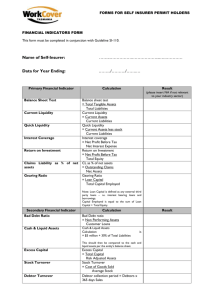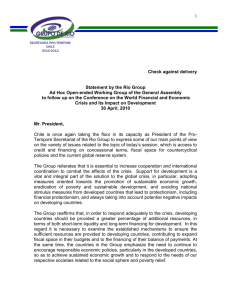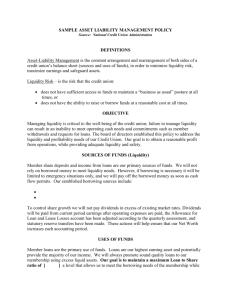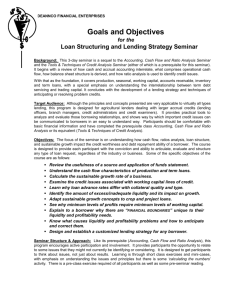C Impacts of Tighter Credit in Agriculture Supply of Capital, Credit, Liquidity
advertisement
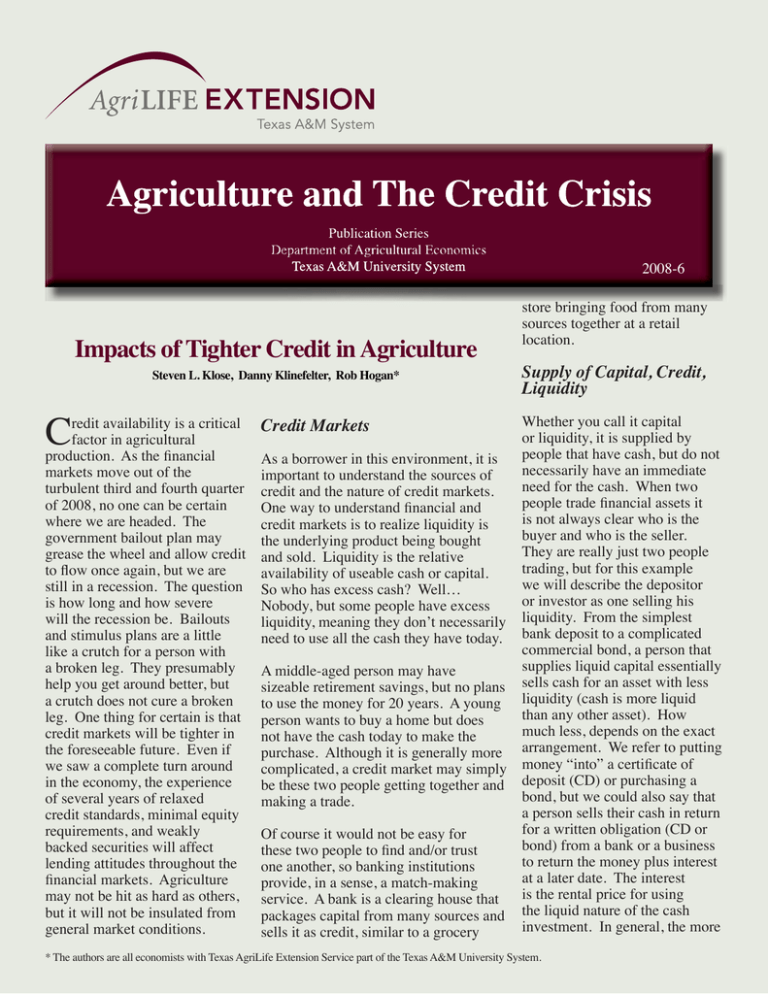
2008-6 Impacts of Tighter Credit in Agriculture Steven L. Klose, Danny Klinefelter, Rob Hogan* C redit availability is a critical factor in agricultural production. As the financial markets move out of the turbulent third and fourth quarter of 2008, no one can be certain where we are headed. The government bailout plan may grease the wheel and allow credit to flow once again, but we are still in a recession. The question is how long and how severe will the recession be. Bailouts and stimulus plans are a little like a crutch for a person with a broken leg. They presumably help you get around better, but a crutch does not cure a broken leg. One thing for certain is that credit markets will be tighter in the foreseeable future. Even if we saw a complete turn around in the economy, the experience of several years of relaxed credit standards, minimal equity requirements, and weakly backed securities will affect lending attitudes throughout the financial markets. Agriculture may not be hit as hard as others, but it will not be insulated from general market conditions. Credit Markets As a borrower in this environment, it is important to understand the sources of credit and the nature of credit markets. One way to understand financial and credit markets is to realize liquidity is the underlying product being bought and sold. Liquidity is the relative availability of useable cash or capital. So who has excess cash? Well… Nobody, but some people have excess liquidity, meaning they don’t necessarily need to use all the cash they have today. A middle-aged person may have sizeable retirement savings, but no plans to use the money for 20 years. A young person wants to buy a home but does not have the cash today to make the purchase. Although it is generally more complicated, a credit market may simply be these two people getting together and making a trade. Of course it would not be easy for these two people to find and/or trust one another, so banking institutions provide, in a sense, a match-making service. A bank is a clearing house that packages capital from many sources and sells it as credit, similar to a grocery store bbringing i i ffood d ffrom many sources together at a retail location. Supply of Capital, Credit, Liquidity Whether you call it capital or liquidity, it is supplied by people that have cash, but do not necessarily have an immediate need for the cash. When two people trade financial assets it is not always clear who is the buyer and who is the seller. They are really just two people trading, but for this example we will describe the depositor or investor as one selling his liquidity. From the simplest bank deposit to a complicated commercial bond, a person that supplies liquid capital essentially sells cash for an asset with less liquidity (cash is more liquid than any other asset). How much less, depends on the exact arrangement. We refer to putting money “into” a certificate of deposit (CD) or purchasing a bond, but we could also say that a person sells their cash in return for a written obligation (CD or bond) from a bank or a business to return the money plus interest at a later date. The interest is the rental price for using the liquid nature of the cash investment. In general, the more * The authors are all economists with Texas AgriLife Extension Service part of the Texas A&M University System. liquidity a person sells in this transaction, the more they are compensated. Interest accrues over time, so foregoing cash for a longer period will generally earn a higher total return. In some cases the written obligation carries some risk, whether in the actual terms or in the reputation of the grantor, in which case the buyer provides a higher rate of return (price) for the use of the capital. In early fall 2008, the value of many return obligations tied to real estate became so questionable no one was willing to supply their liquid capital to the market. Demand for Capital On the other side of the transaction are those that purchase liquidity. We do not often think of a bank deposit as letting someone else use our money. In fact, the bank is in the business of taking deposits and letting others use the money to buy cars, buy houses, start new business, etc. A person that takes out a loan is essentially purchasing liquid capital, and the price they pay is the interest on the loan as the principal is repaid over time. In this case the bank makes a profit by selling the liquidity for more than they paid to the depositor. It is a profit they earn by providing a secure and trustworthy clearing house for people trading the use of capital. Demand for Credit in Production Agriculture Production agriculture is a capital intensive business, and therefore access to credit is critical. Intermediate and longer term credit needs include financing for real estate, equipment, breeding livestock, or investment in new technology. Shorter term capital requirements include annual operating loans for crop production or the cost of purchasing stocker cattle. Due to the crisis of credit availability, financing for these activities could become more difficult to obtain with less overall capital flowing into the financial markets. impacted and the most prepared to continue business as usual. A bank that relies primarily on local deposits and savings to source loans should see little change in their access to capital to make agricultural loans. In the long-term however, the bank will have to compete for those deposits and pay market rates to maintain the same level of capital sources. The most immediate impact would be on operating lines of credit for 2009 production. Longer term capital investments are not typically as urgent, therefore longer term financing needs may be delayed in a tight credit market. Operating loans, however, are critical to annual production and staying in business. If you do not have the money and can not borrow the money for fuel, seed, and fertilizer then you can not put a crop in the ground. Farmers and ranchers may also need short term credit to finance carry-over notes from unprofitable past production seasons. Additionally, some marketing strategies require borrowed capital to hold hedge positions or purchase positions in commodity options. Over a longer period of time, the lack of available credit could impact the demand for real estate, equipment, and business investment in general (therefore the worries about the overall economy following a credit crisis). Larger holding company banks would typically have a solid base of deposits to loan, but they also depend heavily on secondary markets both to acquire capital as well as sell loan assets. For any size bank, matching the maturity of deposits and loans is important, and secondary financial markets can provide that service. For example, when a bank writes a 30 year fixed rate loan, it can not match the loan with a similar fixed rate deposit for that length of time. A solution is to either obtain long term capital through bonds or to sell the loan to another institution thus removing it from the bank’s portfolio. When access to these secondary financial markets is limited, a bank’s retail lending practices may be severely impacted. Sources of Agriculture Credit Farm Credit System There are a number of agricultural credit providers including small independent banks, larger holding company banks, the cooperative farm credit system, government agencies, and other business related or captive financing sources. The impact of a tight credit market will vary across these types of institutions. The Farm Credit System is the largest agricultural lending institution in the country. It is a system of borrower owned cooperatives in place specifically to provide credit for agriculture. Unlike a bank, the farm credit system does not take deposits, so the system’s primary source of capital is the offering of bonds in the bond market. As a government sponsored entity (GSE) investors would typically Banks In the short run, the small rural independent bank may be the least see Farm Credit System bonds as a safe investment, but with the failures of Fannie Mae and Freddie Mac (also GSE’s) those investors may become leery. Furthermore, the explicit federal guarantee of Fannie and Freddie debt securities and private sector commercial paper has unintentionally distorted the market making it more difficult for the farm credit system to acquire funds because its commercial paper does not carry the same explicit guarantee. In the end enticing investors to farm credit system bonds is likely to be more expensive and capital may be limited, resulting in rationing of retail credit through the system and/or higher interest rates. Government Agency Loans The United States Department of Agriculture (USDA) through the Farm Service Agency (FSA) also lends directly to farmers and ranchers. Generally considered the “lender of last resort,” the government lending program has historically been in place to ensure the availability of credit for the production of the nation’s food and fiber. In addition to direct loans, the FSA also underwrites or provides guarantees for agricultural loans made by private sector lenders such as commercial banks and the farm credit system. If you use FSA financing, it is important to know that the lending process takes considerably more time than private sector lending, so start early. While FSA funding is not directly reduced by a credit market freeze, it is safe to assume the demand for FSA loans and loan guarantees will increase as normal credit sources are limited and credit requirements are increased. Captive Financing Another source of capital for production agriculture is captive financing. Captive financing is the extending of credit that is tied to another business transaction or contract. For example, tractor and equipment dealers often provide financing to buyers. In other cases, a commodity buyer may offer a contract that includes financing of some production costs for the producer. These sources of capital depend on the company’s ability to obtain capital in bond and equity markets, and it may also become restricted when the financial markets are in turmoil. make sense for the coming year. Actually, it is sound advice in any situation, but critically important today. First, it is important to understand that for reasons beyond the farmer-lender relationship, availability of credit may be limited, and the lender may be forced to limit loans. Planning ahead and staying ahead of your financial needs will improve your relationship with you lender. It is also important to start the conversation with your lender sooner rather than later about 2009 credit needs. In essence, if credit is limited, you want to get to the front of the line, be prepared, and make sure your lender knows you are prepared. Credit Outlook It would also be wise to consider other ways to create liquidity within your operation. If On a positive note, credit standards in possible, debt restructuring agriculture did not slip as far as those in the general home mortgage arena. It may extend payments creating would seem that agriculture learned (and liquidity today. Non-bank sources of credit may also reduce remembered) its lesson from the early operating loan needs. Where 1980’s when the bottom fell out from under an industry that had levered up on possible, you may consider nontraditional business models or inflated land values. In the short term, farm profits and repayment capacity are partnerships that create liquidity. still currently strong. These factors may While it should not be the driving force on production decisions, provide some insulation to agriculture, you should consider the liquidity but it will not completely protect the needs of various production industry from a reduction in loanable plans. Changing tenure funds. Add the natural tendency for stricter lending requirements, following arrangements with landlords may also reduce the need for credit. a financial crisis that many blame on relaxed credit standards, and lenders are The important factor is to plan ahead and consider your options likely to respond by rationing credit to while you still control your the most qualified borrowers. options. So what are farmers and ranchers to do in the face of a potential credit squeeze for 2009? Several bits of sound advice Visit Texas AgriLife Extension Service at http://AgriLifeExtension.tamu.edu. Educational programs of the Texas AgriLife Extension Service are open to all people without regard to race, color, sex, disability, religion, age, or national origin.Issued in furtherance of Cooperative Extension Work in Agriculture and Home Economics, Acts of Congress of May 8, 1914, as amended, and June 30, 1914, in cooperation with the United States Department of Agriculture. Edward G. Smith, Director, Texas AgriLife Extension Service, The Texas A&M System.
